Tubulin Polyglutamylation by TTLL1 and TTLL7 Regulate Glutamate Concentration in the Mice Brain
Abstract
1. Introduction
2. Materials and Methods
2.1. Generation of Knockout Mice
2.2. Antibodies
2.3. Chemicals
2.4. Mouse Behavior Analysis
2.5. Immunoblot
2.6. 2D Electrophoresis
2.7. Wire Hang Test
2.8. Grip Strength Test
2.9. Porsolt Forced Swim Test
2.10. Social Interaction in Home Cage
2.11. Elevated plus Maze
2.12. Kindling Test
2.13. MALDI IMS
2.14. Immunohistochemistry
2.15. Transmission Electron Microscopy
2.16. LC-MS/MS
3. Results
3.1. Generation of Ttll7 Knockout Mice, Ttll1 and Ttll7 Knockout Reduced Polyglutamylated α- and β-Tubulins, Respectively
3.2. Ttll1 and Ttll7 Knockout Changed the Tubulin Electrical Properties
3.3. Ttll Knockout Mice Showed Several Abnormal Behaviors
3.4. Knockout of Ttll1 and Ttll7 Increased Glutamate Concentration in Mouse Brain
3.5. Ttll Knockout Does Not Change the Overall Structures of the Mouse Brain
3.6. Ttll1/Ttll7 Double Knockout Mice Decreased Neurofilaments in the Dendrites
3.7. LC-MS/MS Quantitative Analyses of Glutamate Indicated no Difference between the Brains of Ttll Knockout and WT Mice
4. Discussion
5. Conclusions
Supplementary Materials
Author Contributions
Funding
Institutional Review Board Statement
Informed Consent Statement
Data Availability Statement
Conflicts of Interest
References
- Zhou, Y.; Danbolt, N.C. Glutamate as a neurotransmitter in the healthy brain. J. Neural Transm. 2014, 121, 799–817. [Google Scholar] [CrossRef] [PubMed]
- Zhu, H.; Wang, N.; Yao, L.; Chen, Q.; Zhang, R.; Qian, J.; Hou, Y.; Guo, W.; Fan, S.; Liu, S.; et al. Moderate UV Exposure Enhances Learning and Memory by Promoting a Novel Glutamate Biosynthetic Pathway in the Brain. Cell 2018, 173, 1716–1727. [Google Scholar] [CrossRef] [PubMed]
- Andersen, J.V.; Markussen, K.H.; Jakobsen, E.; Schousboe, A.; Waagepetersen, H.S.; Rosenberg, P.A.; Aldana, B.I. Glutamate metabolism and recycling at the excitatory synapse in health and neurodegeneration. Neuropharmacology 2021, 196, 108719. [Google Scholar] [CrossRef] [PubMed]
- Bradford, H.F.; Ward, H.K.; Thomas, A.J. Glutamine—A major substrate for nerve endings. J. Neurochem. 1978, 30, 1453–1459. [Google Scholar] [CrossRef]
- Hamberger, A.C.; Chiang, G.H.; Nylén, E.S.; Scheff, S.W.; Cotman, C.W. Glutamate as a CNS transmitter. I. Evaluation of glucose and glutamine as precursors for the synthesis of preferentially released glutamate. Brain Res. 1979, 168, 513–530. [Google Scholar] [CrossRef]
- Featherstone, D.E. Intercellular glutamate signaling in the nervous system and beyond. ACS Chem. Neurosci. 2010, 1, 4–12. [Google Scholar] [CrossRef]
- Choi, D. Glutamate neurotoxicity and diseases of the nervous system. Neuron 1988, 1, 623–634. [Google Scholar] [CrossRef]
- Hoffman, E.M.; Zhang, Z.; Schechter, R.; Miller, K.E. Glutaminase Increases in Rat Dorsal Root Ganglion Neurons after Unilateral Adjuvant-Induced Hind Paw Inflammation. Biomolecules 2016, 6, 10. [Google Scholar] [CrossRef]
- Edde, B.; Rossier, J.; Le Caer, J.P.; Desbruyeres, E.; Gros, F.; Denoulet, P. Posttranslational glutamylation of alpha-tubulin. Science 1990, 247, 83–85. [Google Scholar] [CrossRef]
- Alexander, J.E.; Hunt, D.F.; Lee, M.K.; Shabanowitz, J.; Michel, H.; Berlin, S.C.; MacDonald, T.L.; Sundberg, R.J.; Rebhun, L.I.; Frankfurter, A. Characterization of posttranslational modifications in neuron-specific class III beta-tubulin by mass spectrometry. Proc. Natl. Acad. Sci. USA 1991, 88, 4685–4689. [Google Scholar] [CrossRef]
- Janke, C.; Rogowski, K.; Wloga, D.; Regnard, C.; Kajava, A.V.; Strub, J.-M.; Temurak, N.; van Dijk, J.; Boucher, D.; van Dorsselaer, A.; et al. Tubulin Polyglutamylase Enzymes Are Members of the TTL Domain Protein Family. Science 2005, 308, 1758–1762. [Google Scholar] [CrossRef]
- Ikegami, K.; Mukai, M.; Tsuchida, J.; Heier, R.L.; Macgregor, G.R.; Setou, M. TTLL7 is a mammalian beta-tubulin polyglutamylase required for growth of MAP2-positive neurites. J. Biol. Chem. 2006, 281, 30707–30716. [Google Scholar] [CrossRef]
- Ikegami, K.; Heier, R.L.; Taruishi, M.; Takagi, H.; Mukai, M.; Shimma, S.; Taira, S.; Hatanaka, K.; Morone, N.; Yao, I.; et al. Loss of alpha-tubulin polyglutamylation in ROSA22 mice is associated with abnormal targeting of KIF1A and modulated synaptic function. Proc. Natl. Acad. Sci. USA 2007, 104, 3213–3218. [Google Scholar] [CrossRef]
- Janke, C.; Magiera, M.M. The tubulin code and its role in controlling microtubule properties and functions. Nat. Rev. Mol. Cell Biol. 2020, 21, 307–326. [Google Scholar] [CrossRef]
- Lessard, D.V.; Zinder, O.J.; Hotta, T.; Verhey, K.J.; Ohi, R.; Berger, C.L. Polyglutamylation of tubulin’s C-terminal tail controls pausing and motility of kinesin-3 family member KIF1A. J. Biol. Chem. 2019, 294, 6353–6363. [Google Scholar] [CrossRef]
- Genova, M.; Grycova, L.; Puttrich, V.; Magiera, M.M.; Lansky, Z.; Janke, C.; Braun, M. Tubulin polyglutamylation differentially regulates microtubule-interacting proteins. EMBO J. 2023, 42, e112101. [Google Scholar] [CrossRef]
- Fujishima, R.; Kugo, H.; Yanagimoto, K.; Enomoto, H.; Moriyama, T.; Zaima, N. Similar distribution of orally administered eicosapentaenoic acid and M2 macrophage marker in the hypoperfusion-induced abdominal aortic aneurysm wall. Food Funct. 2021, 12, 3469–3475. [Google Scholar] [CrossRef]
- Takeo, E.; Fukusaki, E.; Shimma, S. Mass Spectrometric Enzyme Histochemistry Method Developed for Visualizing in Situ Cholinesterase Activity in Mus musculus and Drosophila melanogaster. Anal. Chem. 2020, 92, 12379–12386. [Google Scholar] [CrossRef]
- Ryan, D.J.; Spraggins, J.M.; Caprioli, R.M. Protein identification strategies in MALDI imaging mass spectrometry: A brief review. Curr. Opin. Chem. Biol. 2019, 48, 64–72. [Google Scholar] [CrossRef]
- Shariatgorji, M.; Nilsson, A.; Goodwin, R.J.; Kallback, P.; Schintu, N.; Zhang, X.; Crossman, A.R.; Bezard, E.; Svenningsson, P.; Andren, P.E. Direct targeted quantitative molecular imaging of neurotransmitters in brain tissue sections. Neuron 2014, 84, 697–707. [Google Scholar] [CrossRef]
- Eto, F.; Sato, S.; Setou, M.; Yao, I. Region-specific effects of Scrapper on the abundance of glutamate and gamma-aminobutyric acid in the mouse brain. Sci. Rep. 2020, 10, 7435. [Google Scholar] [CrossRef] [PubMed]
- Ikegami, K.; Sato, S.; Nakamura, K.; Ostrowski, L.E.; Setou, M. Tubulin polyglutamylation is essential for airway ciliary function through the regulation of beating asymmetry. Proc. Natl. Acad. Sci. USA 2010, 107, 10490–10495. [Google Scholar] [CrossRef] [PubMed]
- Katano, T.; Takao, K.; Abe, M.; Yamazaki, M.; Watanabe, M.; Miyakawa, T.; Sakimura, K.; Ito, S. Distribution of Caskin1 protein and phenotypic characterization of its knockout mice using a comprehensive behavioral test battery. Mol. Brain 2018, 11, 63. [Google Scholar] [CrossRef] [PubMed]
- Miyakawa, T.; Yamada, M.; Duttaroy, A.; Wess, J. Hyperactivity and Intact Hippocampus-Dependent Learning in Mice Lacking the M<sub>1</sub>Muscarinic Acetylcholine Receptor. J. Neurosci. 2001, 21, 5239–5250. [Google Scholar] [PubMed]
- Takao, K.; Tanda, K.; Nakamura, K.; Kasahara, J.; Nakao, K.; Katsuki, M.; Nakanishi, K.; Yamasaki, N.; Toyama, K.; Adachi, M.; et al. Comprehensive behavioral analysis of calcium/calmodulin-dependent protein kinase IV knockout mice. PLoS ONE 2010, 5, e9460. [Google Scholar] [CrossRef]
- Mao, X.Y.; Zhou, H.H.; Jin, W.L. Ferroptosis Induction in Pentylenetetrazole Kindling and Pilocarpine-Induced Epileptic Seizures in Mice. Front. Neurosci. 2019, 13, 721. [Google Scholar] [CrossRef]
- Mori, T.; Wakabayashi, T.; Ogawa, H.; Hirahara, Y.; Koike, T.; Yamada, H. Increased histone H3 phosphorylation in neurons in specific brain structures after induction of status epilepticus in mice. PLoS ONE 2013, 8, e77710. [Google Scholar] [CrossRef]
- Han, X.M.; Qin, Y.J.; Zhu, Y.; Zhang, X.L.; Wang, N.X.; Rang, Y.; Zhai, X.J.; Lu, Y.N. Development of an underivatized LC-MS/MS method for quantitation of 14 neurotransmitters in rat hippocampus, plasma and urine: Application to CUMS induced depression rats. J. Pharm. Biomed. Anal. 2019, 174, 683–695. [Google Scholar] [CrossRef]
- Wojnicz, A.; Avendano Ortiz, J.; Casas, A.I.; Freitas, A.E.; Lopez, M.G.; Ruiz-Nuno, A. Simultaneous determination of 8 neurotransmitters and their metabolite levels in rat brain using liquid chromatography in tandem with mass spectrometry: Application to the murine Nrf2 model of depression. Clin. Chim. Acta 2016, 453, 174–181. [Google Scholar] [CrossRef]
- Maragakis, N.J.; Rothstein, J.D. Glutamate Transporters in Neurologic Disease. Arch. Neurol. 2001, 58, 365–370. [Google Scholar] [CrossRef]
- Audebert, S.; Koulakoff, A.; Berwald-Netter, Y.; Gros, F.; Denoulet, P.; Edde, B. Developmental regulation of polyglutamylated alpha- and beta-tubulin in mouse brain neurons. J. Cell Sci. 1994, 107 Pt 8, 2313–2322. [Google Scholar] [CrossRef]
- Przyborski, S.A.; Cambray-Deakin, M.A. Profile of glutamylated tubulin expression during cerebellar granule cell development in vitro. Dev. Brain Res. 1997, 100, 133–138. [Google Scholar] [CrossRef]
- Lee, M.K.; Marszalek, J.R.; Cleveland, D.W. A mutant neurofilament subunit causes massive, selective motor neuron death: Implications for the pathogenesis of human motor neuron disease. Neuron 1994, 13, 975–988. [Google Scholar] [CrossRef]
- Kong, J.; Tung, V.W.; Aghajanian, J.; Xu, Z. Antagonistic roles of neurofilament subunits NF-H and NF-M against NF-L in shaping dendritic arborization in spinal motor neurons. J. Cell Biol. 1998, 140, 1167–1176. [Google Scholar] [CrossRef]
- Xia, C.H.; Roberts, E.A.; Her, L.S.; Liu, X.; Williams, D.S.; Cleveland, D.W.; Goldstein, L.S. Abnormal neurofilament transport caused by targeted disruption of neuronal kinesin heavy chain KIF5A. J. Cell Biol. 2003, 161, 55–66. [Google Scholar] [CrossRef]
- He, Y.; Francis, F.; Myers, K.A.; Yu, W.; Black, M.M.; Baas, P.W. Role of cytoplasmic dynein in the axonal transport of microtubules and neurofilaments. J. Cell Biol. 2005, 168, 697–703. [Google Scholar] [CrossRef]
- Motil, J.; Chan, W.K.; Dubey, M.; Chaudhury, P.; Pimenta, A.; Chylinski, T.M.; Ortiz, D.T.; Shea, T.B. Dynein mediates retrograde neurofilament transport within axons and anterograde delivery of NFs from perikarya into axons: Regulation by multiple phosphorylation events. Cell Motil. Cytoskelet. 2006, 63, 266–286. [Google Scholar] [CrossRef]
- Robert, A.; Tian, P.; Adam, S.A.; Kittisopikul, M.; Jaqaman, K.; Goldman, R.D.; Gelfand, V.I. Kinesin-dependent transport of keratin filaments: A unified mechanism for intermediate filament transport. FASEB J. 2019, 33, 388–399. [Google Scholar] [CrossRef]
- Wolff, A.; de Néchaud, B.; Chillet, D.; Mazarguil, H.; Desbruyères, E.; Audebert, S.; Eddé, B.; Gros, F.; Denoulet, P. Distribution of glutamylated alpha and beta-tubulin in mouse tissues using a specific monoclonal antibody, GT335. Eur. J. Cell Biol. 1992, 59, 425–432. [Google Scholar] [PubMed]
- Redeker, V.; Rossier, J.; Frankfurter, A. Posttranslational modifications of the C-terminus of alpha-tubulin in adult rat brain: Alpha 4 is glutamylated at two residues. Biochemistry 1998, 37, 14838–14844. [Google Scholar] [CrossRef] [PubMed]
- Redeker, V. Mass Spectrometry Analysis of C-Terminal Posttranslational Modifications of Tubulins. In Microtubules, In Vitro; Elsevier Science: Amsterdam, The Netherlands, 2010; pp. 77–103. [Google Scholar]
- Meldrum, B.S. The role of glutamate in epilepsy and other CNS disorders. Neurology 1994, 44 (Suppl. S8), S14–S23. [Google Scholar] [PubMed]
- Lewerenz, J.; Maher, P. Chronic Glutamate Toxicity in Neurodegenerative Diseases-What is the Evidence? Front. Neurosci. 2015, 9, 469. [Google Scholar] [CrossRef]
- Zhang, B.; Vogelzang, A.; Miyajima, M.; Sugiura, Y.; Wu, Y.; Chamoto, K.; Nakano, R.; Hatae, R.; Menzies, R.J.; Sonomura, K.; et al. B cell-derived GABA elicits IL-10(+) macrophages to limit anti-tumour immunity. Nature 2021, 599, 471–476. [Google Scholar] [CrossRef]
- Bak, L.K.; Schousboe, A.; Waagepetersen, H.S. The glutamate/GABA-glutamine cycle: Aspects of transport, neurotransmitter homeostasis and ammonia transfer. J. Neurochem. 2006, 98, 641–653. [Google Scholar] [CrossRef]
- Porter, T.G.; Martin, D.L. Evidence for feedback regulation of glutamate decarboxylase by gamma-aminobutyric acid. J. Neurochem. 1984, 43, 1464–1467. [Google Scholar] [CrossRef]
- Yudkoff, M. Brain metabolism of branched-chain amino acids. Glia 1997, 21, 92–98. [Google Scholar] [CrossRef]
- Yudkoff, M. Interactions in the Metabolism of Glutamate and the Branched-Chain Amino Acids and Ketoacids in the CNS. Neurochem. Res. 2017, 42, 10–18. [Google Scholar] [CrossRef]
- Ramadan, Y.H.; Gu, A.; Ross, N.; McEwan, S.A.; Barr, M.M.; Firestein, B.L.; O’Hagan, R. CCP1, a Tubulin Deglutamylase, Increases Survival of Rodent Spinal Cord Neurons following Glutamate-Induced Excitotoxicity. Eneuro 2021, 8, ENEURO.0431-20.2021. [Google Scholar] [CrossRef]
- Egashira, Y.; Takase, M.; Watanabe, S.; Ishida, J.; Fukamizu, A.; Kaneko, R.; Yanagawa, Y.; Takamori, S. Unique pH dynamics in GABAergic synaptic vesicles illuminates the mechanism and kinetics of GABA loading. Proc. Natl. Acad. Sci. USA 2016, 113, 10702–10707. [Google Scholar] [CrossRef]
- Ottersen, O.P. Quantitative electron microscopic immunocytochemistry of neuroactive amino acids. Anat. Embryol. 1989, 180, 1–15. [Google Scholar] [CrossRef]
- Fonnum, F. Glutamate: A neurotransmitter in mammalian brain. J. Neurochem. 1984, 42, 1–11. [Google Scholar] [CrossRef] [PubMed]

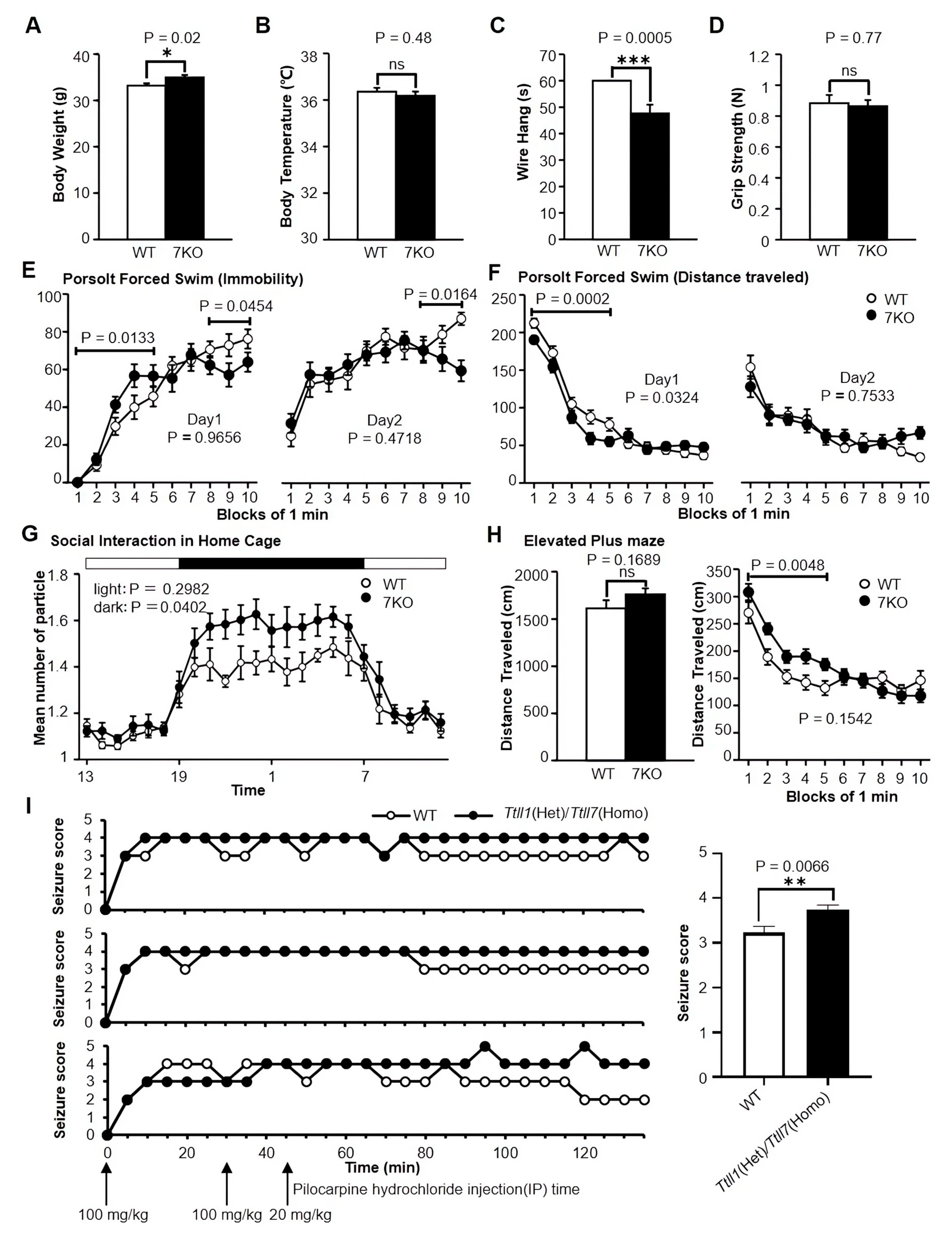
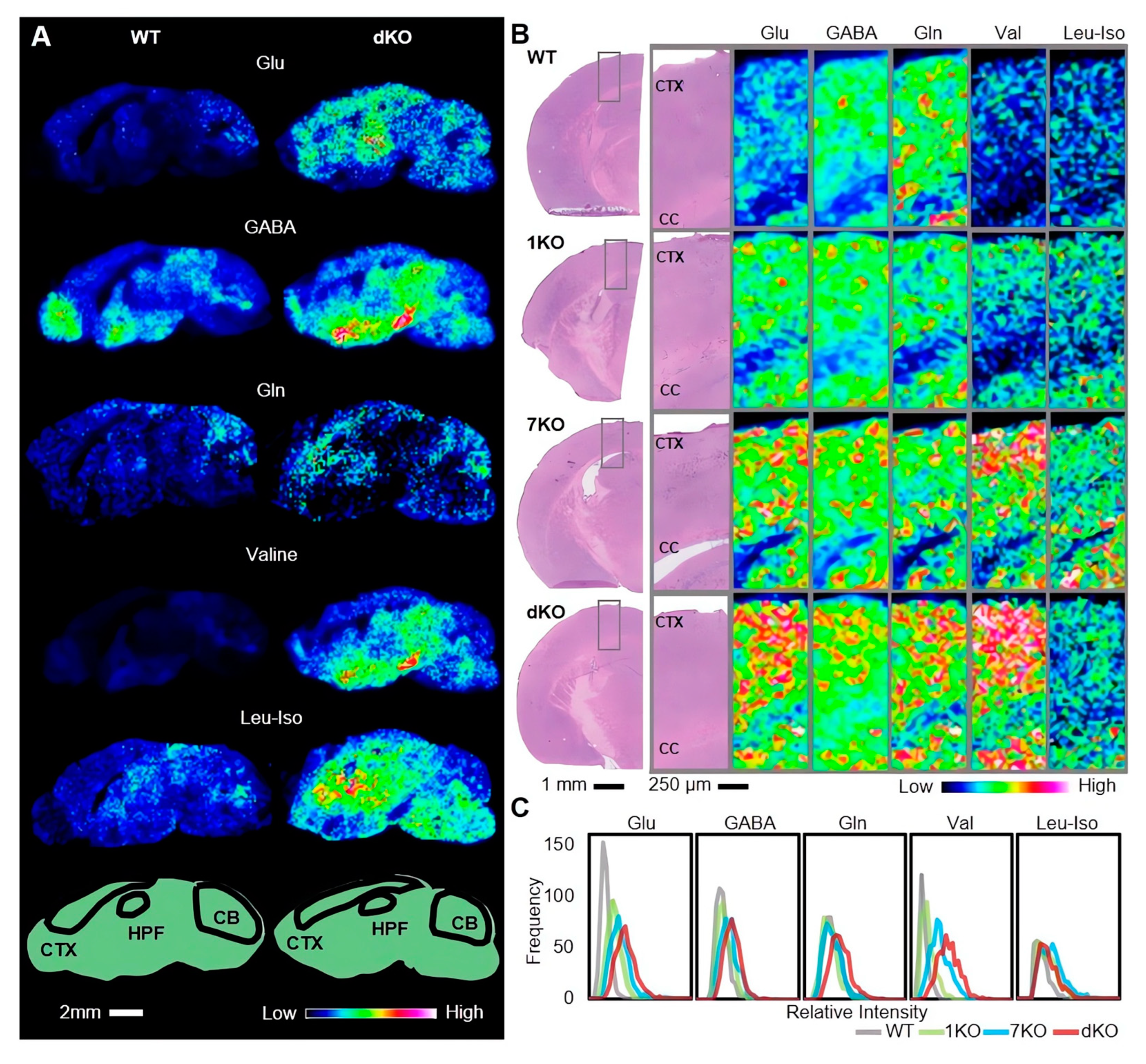
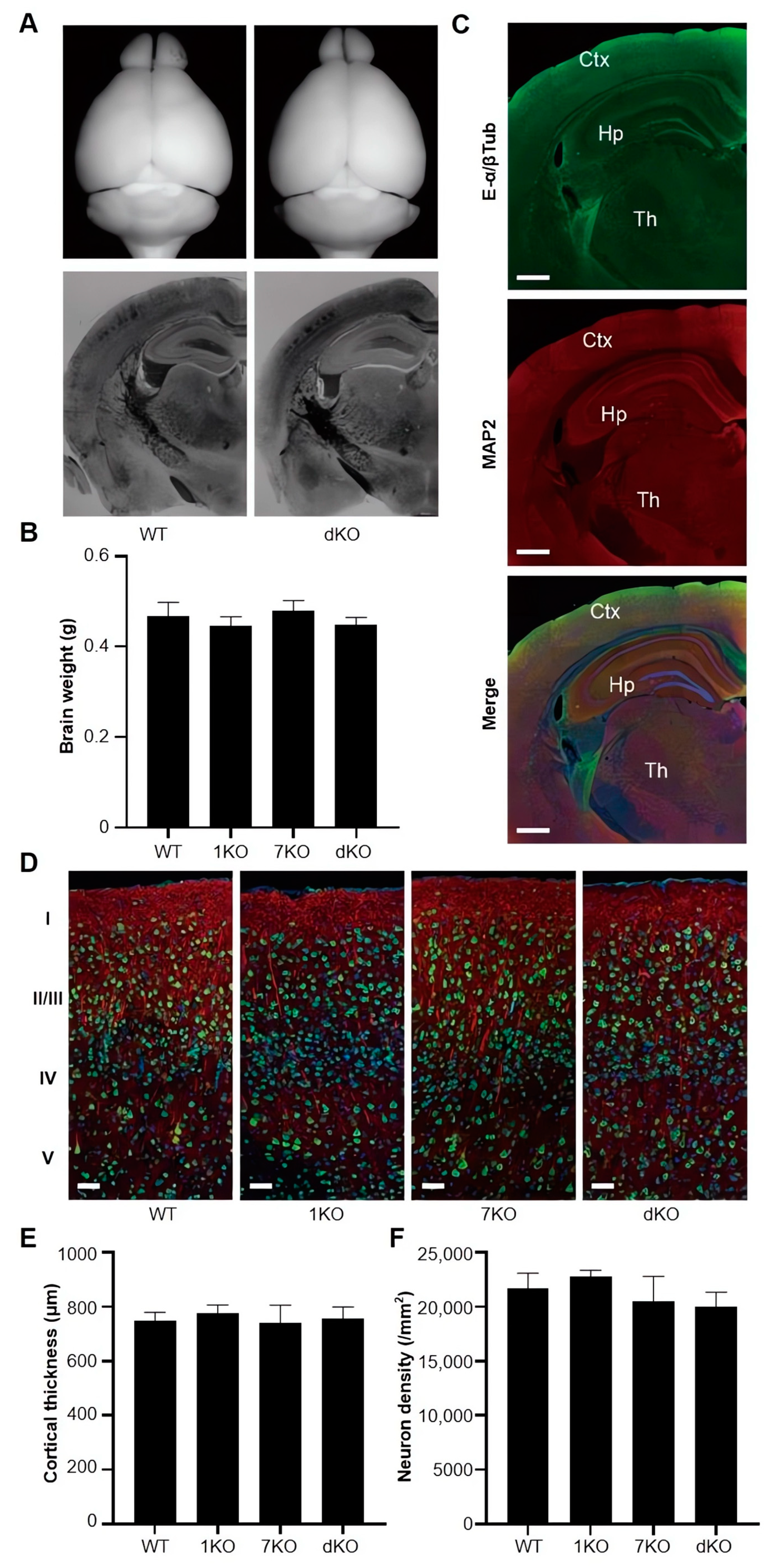
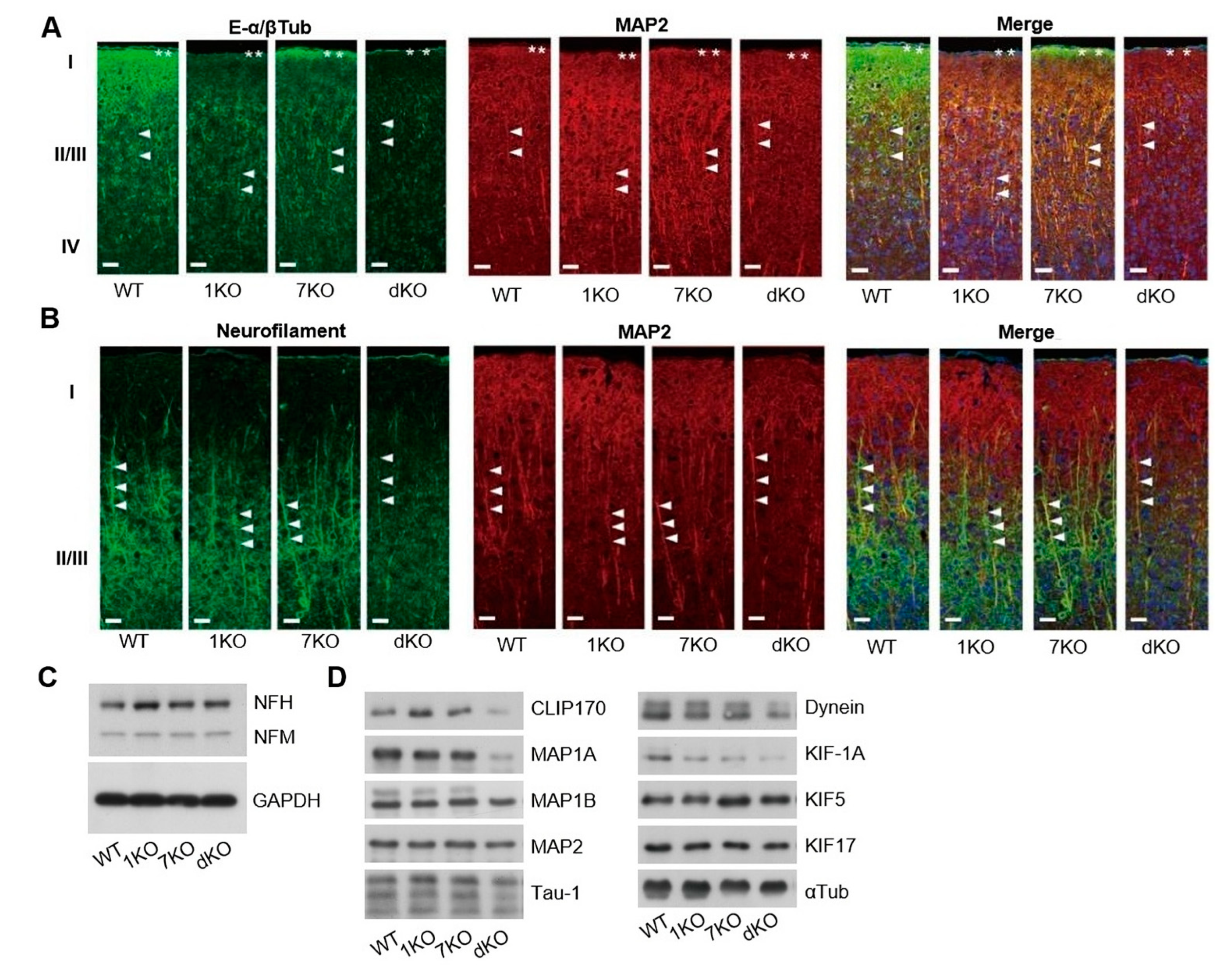
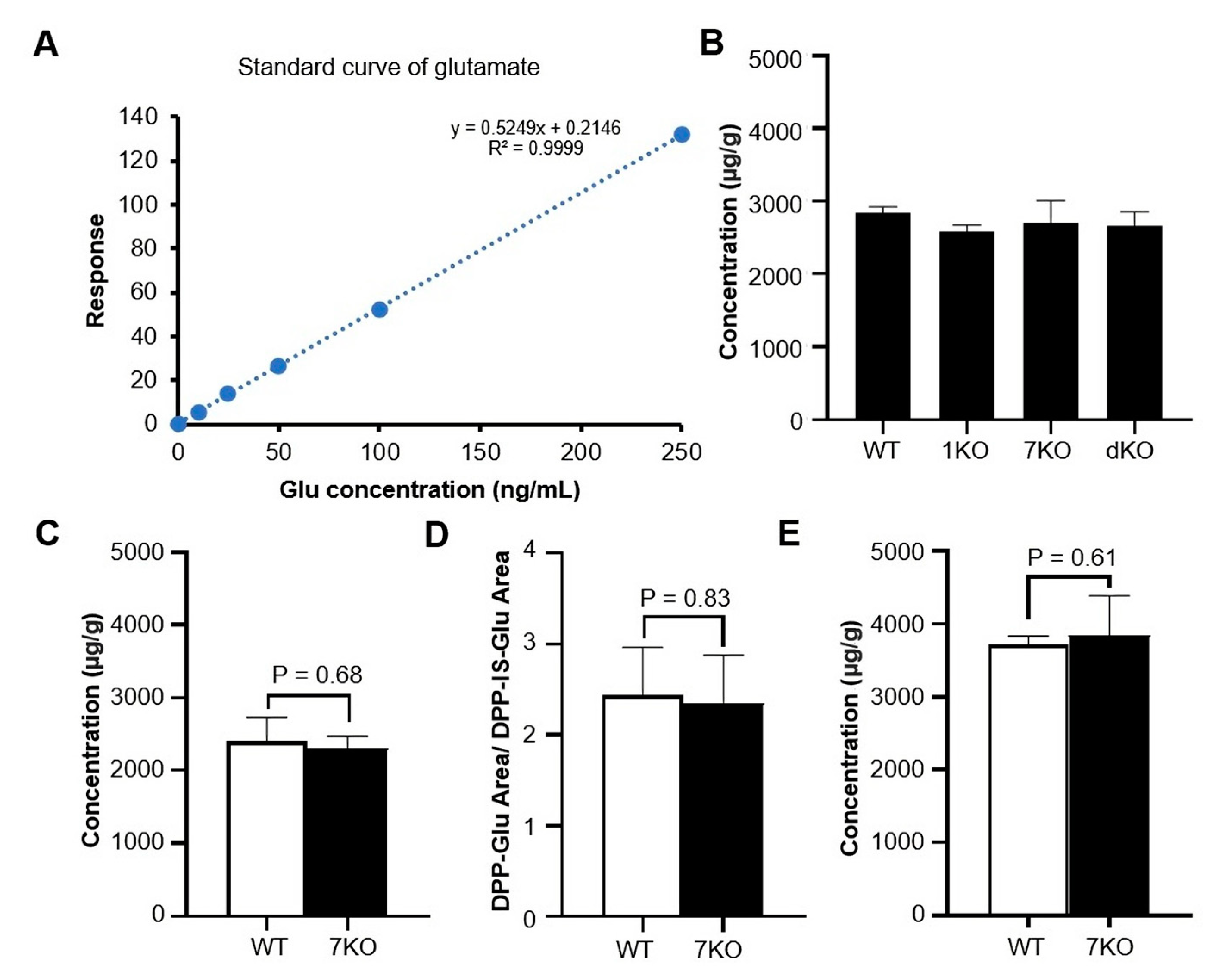
| Glu | GABA | Gln | Val | Leu-Iso | ||||||
|---|---|---|---|---|---|---|---|---|---|---|
| p | Effect Size | p | Effect Size | p | Effect Size | p | Effect Size | p | Effect Size | |
| CTX | <0.001 | 0.757 | <0.001 | 0.332 | <0.001 | 0.209 | <0.001 | 0.653 | <0.001 | 0.372 |
| HPF | <0.001 | 0.761 | <0.001 | 0.462 | 0.078 | 0.12 | <0.001 | 0.796 | <0.001 | 0.552 |
| CB | <0.001 | 0.535 | <0.001 | 0.431 | <0.001 | 0.334 | <0.001 | 0.82 | <0.001 | 0.333 |
| Glu | GABA | Gln | Val | Leu-Iso | ||||||
|---|---|---|---|---|---|---|---|---|---|---|
| p | Effect Size | p | Effect Size | p | Effect Size | p | Effect Size | p | Effect Size | |
| CTX | <0.001 | 0.572 | <0.001 | 0.241 | <0.001 | 0.179 | <0.001 | 0.666 | <0.001 | 0.172 |
Disclaimer/Publisher’s Note: The statements, opinions and data contained in all publications are solely those of the individual author(s) and contributor(s) and not of MDPI and/or the editor(s). MDPI and/or the editor(s) disclaim responsibility for any injury to people or property resulting from any ideas, methods, instructions or products referred to in the content. |
© 2023 by the authors. Licensee MDPI, Basel, Switzerland. This article is an open access article distributed under the terms and conditions of the Creative Commons Attribution (CC BY) license (https://creativecommons.org/licenses/by/4.0/).
Share and Cite
Ping, Y.; Ohata, K.; Kikushima, K.; Sakamoto, T.; Islam, A.; Xu, L.; Zhang, H.; Chen, B.; Yan, J.; Eto, F.; et al. Tubulin Polyglutamylation by TTLL1 and TTLL7 Regulate Glutamate Concentration in the Mice Brain. Biomolecules 2023, 13, 784. https://doi.org/10.3390/biom13050784
Ping Y, Ohata K, Kikushima K, Sakamoto T, Islam A, Xu L, Zhang H, Chen B, Yan J, Eto F, et al. Tubulin Polyglutamylation by TTLL1 and TTLL7 Regulate Glutamate Concentration in the Mice Brain. Biomolecules. 2023; 13(5):784. https://doi.org/10.3390/biom13050784
Chicago/Turabian StylePing, Yashuang, Kenji Ohata, Kenji Kikushima, Takumi Sakamoto, Ariful Islam, Lili Xu, Hengsen Zhang, Bin Chen, Jing Yan, Fumihiro Eto, and et al. 2023. "Tubulin Polyglutamylation by TTLL1 and TTLL7 Regulate Glutamate Concentration in the Mice Brain" Biomolecules 13, no. 5: 784. https://doi.org/10.3390/biom13050784
APA StylePing, Y., Ohata, K., Kikushima, K., Sakamoto, T., Islam, A., Xu, L., Zhang, H., Chen, B., Yan, J., Eto, F., Nakane, C., Takao, K., Miyakawa, T., Kabashima, K., Watanabe, M., Kahyo, T., Yao, I., Fukuda, A., Ikegami, K., ... Setou, M. (2023). Tubulin Polyglutamylation by TTLL1 and TTLL7 Regulate Glutamate Concentration in the Mice Brain. Biomolecules, 13(5), 784. https://doi.org/10.3390/biom13050784








